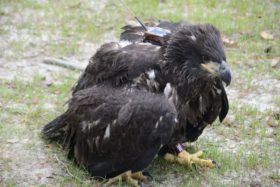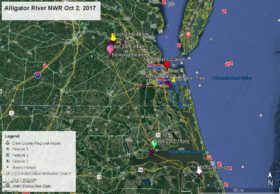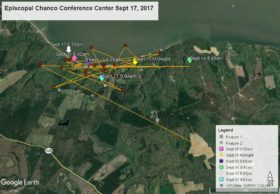Bald Eagle Chick Development
Legacy Lady
April 29, 2011Camellia Returns to Back Bay in Va Beach
May 1, 2011Growth development of bald eagle chicks in the Chesapeake Bay population has been a study subject by biologists at The Center for Conservation Biology. Here is a paper by Dr. Bryan Watts on bald eagle chick weight gain and food requirements.
Stages of Bald Eagle Chick Development – Bald eagle chicks progress through three general phases of development as nestlings including 1) structural growth, 2) feather growth, and 3) neurological and behavioral development. These phases overlap extensively but do exhibit a clear sequence from structural through neurological development. Structural growth includes primary tissue growth (e.g. skeletal and muscular systems). This phase of growth occurs early in the development period and accounts for virtually all of the increases in mass or weight. Different body elements grow at different times through the growth sequence. For example, feet reach their terminal size very early on in development whereas wings and flight muscles develop at a later stage. This sequencing coincides with the “need” for these elements. As nestlings, eagles progress through three different sets of feathers including natal down, thermal down, and juvenile feathers. Chicks are hatched with a coat of natal down. This down is very light in color and does not have much insulating ability such that chicks must be brooded by an adult for warmth. Natal down is replaced by thermal down beginning around 10 days of age. Thermal down has very good insulating qualities and by 15 days chicks are typically able to thermoregulate on their own. The emergence of juvenile feathers including contour and flight feathers typically begins on or before 27 days. These dark feathers are arranged in tracts and emerge in sequence beginning with the capital (head) and dorsal (back) tracts. The ventral (belly) tract is the last feather group to emerge. Flight feathers including the wing and tail continue to grow throughout the development period reaching their maximum lengths around the time of fledging. The last phase of development as nestlings is neurological or the learning of coordinated movements. This includes walking, feeding, and flying. The final month of development is consumed by acquiring the coordination needed for movement and flight.
Pattern of Growth – Like all birds, eagles exhibit an asymptotic pattern of growth meaning that they begin slowly, have a rapid phase of growth, followed by a slowing of growth to terminal size. Adult males are smaller than females such that they reach their terminal sizes at younger ages. In the Chesapeake Bay, males average 3,150 grams (7-8 pounds) and females average 4,225 grams (10-12 pounds). During their period of rapid growth, chicks gain 140-150 grams/day. T90 (time required to reach 90% of terminal weight) is reached between the age of 36 and 42 days depending on gender.
Peak Energy Demand – Depending on temperature and activity, etc. adult bald eagles require approximately 500 grams of fish/day. This includes energy for metabolism and maintenance as well as energy for flying and other activities. Energy demand for chicks includes both maintenance or metabolic requirements, as well as, energy for growth or the development of new tissues. Peak energy demand occurs in the later stage of rapid growth when metabolic demand is high due to large body size and when chicks are still growing at a rapid rate. After terminal size is reached, energy demand declines to that required for maintenance alone and resembles that of adults. In the Chesapeake Bay, peak energy demand occurs around 30 to 35 days of age. One of the most reliable outward signs that chicks have moved past the period of most rapid growth and peak energy demand is when they begin to appear mostly feathered. This appearance reflects that the transition between structural growth and feather growth has been made.
Provisioning – Provisioning of eagle broods within the Chesapeake Bay averages between 3 and 4 fish/day during the period of peak demand. Beyond this period, provisioning is closer to 3 fish/day.
Botanical Garden Brood – When the female was killed on 26 April, 2011, all of the chicks within the botanical garden brood had reached 42 days and had reached T90. This suggests that the brood was well beyond peak energetic demand. The brood had begun the transition to self feeding and the development of juvenile feathers was well advanced. Maintenance of this brood should not have required more than 3 fish per day through the period of fledging. Depending on fish size, it is likely that they could have fledged with an average provisioning rate of below 3 fish/day.
Literature
Markham, A. C. and B. D. Watts. 2008. The influence of salinity on provisioning rates and nestling growth in bald eagles in the lower Chesapeake Bay. Condor 110:183-187.
Markham, A. C. and B. D. Watts. 2008. The influence of salinity on the diet of nesting bald eagles. Journal of Raptor Research 42:99-109.
Watts, B. D. Assessment of body size for Bald Eagles of the Chesapeake Bay. Submitted to Northeastern Naturalist.




18 Comments
That is an interesting article. In the last paragraph, referring the NBG eaglets, does it mean 3 fish/day per eaglet or for all three combined? Does that contradict the argument that the adult male would not have been able to feed the chicks on his own? Though I do feel more comfortable with the chicks being at WCV. I’m unsure if NV would have gotten enough food because of his bigger, more agressive siblings. Thanks!
Mr. Lukei, these were wonderful articles and pictures. I tried to enter the eagle cam and tell everyone to read this paper that you posted. But the web cam stream won’t post my post. I loved it that all your info was right up to the minute current. Thank you for all you’ve done.
Linda NEyland
Thank you very much! I don’t have a degree in anything but I’m serving my 12th year as a volunteer Bald Eagle nest monitor for the Oregon Cooperative Fish & Wildlife Research Unit administered by Oregon State University. I’ve had the luxury of very knowledgeable tutors over the years to guide me. I’ve accumulated over 100 nest cycles in mostly Washington County, OR.
The information you have provided is 100 % spot on with my own field observations. I’ve not the talent to put into words the tremendous explanation which you have. Kudos cum Laude!
There are very few sources available which deal in such accuracy and detail as yours! I only wish every eagle cam “chat moderator” and viewer would take the few moments to learn by reading your blog. Your essay on chick development is simply outstanding, and something I’ve only been able to speculate & hypothesize about. Luckily I got it mostly right.
Sincerely,
Dennis E. Manzer
Beaverton, OR
Reese,
Please send thanks to Dr Watts for such an informative article. As a result of reading this paper, I have an observation and a question.
The father has always been great at foraging. It seems that he was capable of providing 3 fish per day plus fish for himself. I understand that there was no way to wait to see if he was capable, because by the time it could be determined that the eaglets weren’t getting enough food, they would have been too aggressive to remove from the nest. And watching them suffer and harm each other due to lack of food does not make for good eagle cam viewing. Although I understand the decision to remove them, this article makes me wonder if it was really necessary… I acknowledge that there are other reasons — protection from predators being one reason. But the food reason seemed to be the main concern…
My question: How sure are we that NX is a female? I had read that males feather out earlier than females. They reach full mass sooner and energy is then spent on feathers while females are still gaining mass. At the banding, it came up that NX’s tail feathers were more advanced than NZ’s. We saw last year that Camellia tricked everybody. Is it possible that NX is a male? On banding day, NZ was at 80% of average female mass. NV was at 83.5% of average female mass. NX was at 73.3% of average female mass, or 93.4% of average male mass. I know other measurements were taken. For NX, were they more definitive than the weight?
Response – All the various measurements we took not just weight led us to determine NX to be a female.
Oops. Meant to say that NV was at 83.5% of average male mass…
Thank you for posting this enlightening paper by Dr. Watts! I feel a twinge of sorrow and doubt all over again when i read that at their stage of development, the NBG eaglets would only have required 3 fish a day for maintenance…which seems like an easy task for a parent who was observed to bring in more than that on a daily basis. This makes me question the whole argument that the father would not have been able to provide adequately for the chicks, that one or more would have died from starvation and/or would have been attacked and killed by its stronger sibling(s).
Reading this confirms what I intuitively felt. I think they should have waited for a few days before making the decision to remove the eaglets. at this point I just hope the outcome will be positive and the eaglets develop well and will learn on their own, I guess…relying on their own nature’s guidance
I wouldn’t have worried about the father being able to feed the triplets … my worry would have been that a predator would come and killed one or all of them while dad was out hunting for the food. I am very glad they are now safe and sound in captivity where they will definitely continue to thrive. Thanks to everyone involved in the rescue. God Bless you ALL !
Thank you Reese for posting this informative article. As we don’t know all of the reasons for the eaglets being removed, I truly believe they ate in the safest place and cannot wait to see them sent back into the wild. Thanks again.
Hindesight is great, but I myself am so happy they are in a safe envirnoment to grow and ‘prosper’ until release. I feel they will have a better chance of a longer life away from that ‘airport’. Let’s not forget how many eagles have died there. Bless all the folks involved with the events of the last few days. I am still in tears.
I did not and do not agree with the removal of the eaglets from the nest. Human intervention should have been minimal, if at all. I understand intentions are good, but this family is permanently disrupted, and the eaglets have now been subjected to excess handling/human exposure, exams, blood draws, anesthesia, and excess feeding. How can one expect them to ever be completely free from this experience? Innate instincts have handled situations like this for eons. The male was doing what he is programmed to do. Why must humans impose what THEY feel is best? My opinion, this situation was acted upon too quickly; observation was warranted.
Re: predation. Eagle parents spend more and more time away from the nest as the eaglets get older. Predation is an equal risk with one parent or two.
Thank you Reese for sharing Dr. Bryan Watts study. There is some interesting information contained in his words and it supports my thoughts about the decision to remove the chicks from the nest. Far be it for me to question people that do this for a living BUT if the camera was originally installed to study Eagle nesting behavior I think they missed out on a unique opportunity to study the curve balls nature throws at it’s inhabitants. There was nothing “natural” about what happened to the female but in reality it does happen as nature sees fit. This camera brought these Eagles into our homes and lives and unfortunately I think it helped influence the decision that was made…god forbid we actually see how cruel or amazing nature can be…but we will never know in this case.
I’m a small part of the bigger picture of this Eagle family and in a way I feel responsible for the recent events so my stones aren’t going very far.
Thank you Reese, CCB, VDGIF, WVEC, NBG, WCV and everyone else involved surrounding this Eagle family.
I’m with those above who feel a short wait to see how it went might have been best. Right now the eaglets are wary of the human bringing food, but I am sure they will adjust soon enough. That worries me. They will associate humans and food. That could put them in dangerous situations if ever released into the wild. The other side is the double tragedy of being orphaned and also losing their freedom.
CCB: Thank you for the telling post.
Like I believe Duane is saying, I have been rethinking everything.
Should eagles be discouraged from nesting adjacent to airports?
Should we humanize (we don’t mean to, but it happens) them with our cams and publicity?
If this had been an unpublicized nest with no cam and no attention, what would have been the outcome?
Have we missed an opportunity to study real eagle behavior in response to adversity?
I know they are in good hands. I have sent my donation to WCV. Hopefully they will thrive when released into the wild. They certainly have the genes to do so. Like the miraculous convergence of Azelea and Camilia at Back Bay this past weekend, they never cease to amaze.
Great article
BUT ….all the second guessing aside – I am so very thankful that these 3 babies are safe and sound at WCV. These are Mom’s last precious gifts to us. It has hurt me deeply to loose her AND to loose even one of the babies …well I can’t say what it would do to me. Famous babies or not – they have the chance to grow up safely and fly free in a beautiful place.
WCV knows what they are doing – and it is such a weight off MY shoulders that they are there. They have sucessfully rehabbed and released Eagles for a long time and I expect no less of them with these babies. Decision is made babies are safe and to ME that is all that matters.
Thank you Reese,Dr Watts , DGIF, NBG, WVEC and most of all thank you WCV for caring for these precious little gifts from our Beautiful Mom.
Dix
While it may have been possible for the male adult to have finished raising these eaglets successfully by himself, their safety from predators would have been compromised. The likelihood of their safety through the remainder of their growth period to the point of fledging is undoubtedly much better where the are than if they’d been raised by a single parent in the NBG nest. Consider that during the time remaining between the day they were transferred to WCV and fledging, they may have faced another crisis but had become enough bigger and stronger to make removing them from NBG safely, unlikely. As much as we all would have loved to watch the entire process take place in the nest of their hatching, I do believe that they have a better chance of making it into the wild under the exceptional care of the staff at WCV.
on 5/2 at 7;46 CYGGS hit the nail on the head and drove it home. We were the guest at this nest site, it was too early to pull the plug on dad eagle,he was’nt given the chance to live wild.All the time watching this it was repeatedly stressed “these are wild eagles we will not interfear with nature” but they just could’nt keep their hands off.good luck to the 3 eaglets and dad
Of course these eaglets are safer where they are. What will happen in August when they must take care of themselves? Will they have any idea how to do that after being in this very unnatural environment? I hope so.